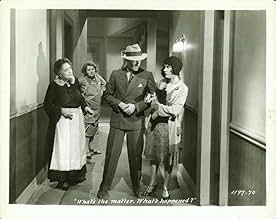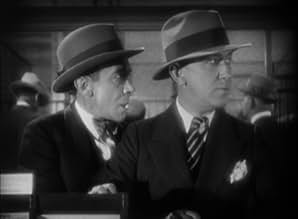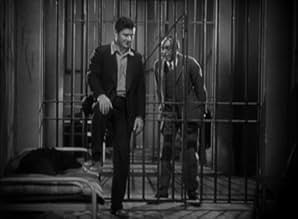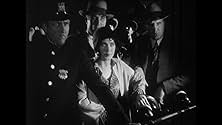VALUTAZIONE IMDb
6,5/10
996
LA TUA VALUTAZIONE
Thunderbolt, noto criminale, rischia l'esecuzione. Nella cella accanto c'è l'innocente Bob Moran, innamorato della ragazza di Thunderbolt. Questi spera di avere abbastanza tempo per poter uc... Leggi tuttoThunderbolt, noto criminale, rischia l'esecuzione. Nella cella accanto c'è l'innocente Bob Moran, innamorato della ragazza di Thunderbolt. Questi spera di avere abbastanza tempo per poter uccidere Moran.Thunderbolt, noto criminale, rischia l'esecuzione. Nella cella accanto c'è l'innocente Bob Moran, innamorato della ragazza di Thunderbolt. Questi spera di avere abbastanza tempo per poter uccidere Moran.
- Regia
- Sceneggiatura
- Star
- Candidato a 1 Oscar
- 2 vittorie e 1 candidatura in totale
Ernie Adams
- Thug in Bank at Robbery
- (non citato nei titoli originali)
Elmer Ballard
- Prisoner #8
- (non citato nei titoli originali)
Louise Beavers
- Black Cat Cafe Patron
- (non citato nei titoli originali)
Ed Brady
- Chuck - 1st Prisoner #5
- (non citato nei titoli originali)
Recensioni in evidenza
Nobody would argue that 1929 was a year of classic movies. Amongst the flotsam and jetsam however there's APPLAUSE and a few other good ones..... and this as well - almost. What a difference a top director and screenwriter can make!
This isn't a gangster film, it's an intelligently written character study and in-depth look into the mind of a mobster. You find writer Jules Furthman's name on virtually every other classic Hollywood picture of the 20s, 30s and 40s. His style was quality and his skill was creating believable engaging stories with real genuine characters. His story was further adapted by H Mankiewicz - who wrote the scripts for the probably the other half of the classics from this period. Needless to say - this is well written with fascinating and deeply faceted characters.
Josef von Sternberg directed this which by the look of it was his fiftieth talkie. Surely it's impossible that this was his first sound film? Being made in 1929, it's still a little experimental, not quite everything works so this is not one of his best pictures. Nevertheless he creates a brooding almost surreal atmosphere with real tension. That style intensifies significantly in the latter part of the film on death row which has an almost dream like feel about it.
The story is tense, the characters are believable, the production is innovative but this is not a perfect film. To enable clear sound recording, some but not all of the actors speak very slowly which sounds especially weird when the actor they're talking with is speaking normally. Actors had their own individual vocal coaches then with different techniques thus the inconsistency and maybe not being a native English speaker, von Sternberg probably didn't notice the subtle differences.
As great a director as he was, von Sternberg was given the impossible task of trying to make Fay Wray seem like a proper actress. Not even he could do that and predictably she's absolutely dreadful. As always she just projects that limp, whining and insipid expression to convey whatever emotion she's trying to express.
Whether she's pretending to be a hard as nails gangster's moll or a reformed, sweet and vulnerable fragile young thing she's that same bland, shallow character. Not only can't she act but in this she doesn't appear to be able to speak English - what on earth is that accent! She's meant to be a girl from the streets so why is she doing history's worst impression of Queen Mary? That two men could be besotted with this dull sour-faced non-entity completely stretches all credibility.
This isn't a gangster film, it's an intelligently written character study and in-depth look into the mind of a mobster. You find writer Jules Furthman's name on virtually every other classic Hollywood picture of the 20s, 30s and 40s. His style was quality and his skill was creating believable engaging stories with real genuine characters. His story was further adapted by H Mankiewicz - who wrote the scripts for the probably the other half of the classics from this period. Needless to say - this is well written with fascinating and deeply faceted characters.
Josef von Sternberg directed this which by the look of it was his fiftieth talkie. Surely it's impossible that this was his first sound film? Being made in 1929, it's still a little experimental, not quite everything works so this is not one of his best pictures. Nevertheless he creates a brooding almost surreal atmosphere with real tension. That style intensifies significantly in the latter part of the film on death row which has an almost dream like feel about it.
The story is tense, the characters are believable, the production is innovative but this is not a perfect film. To enable clear sound recording, some but not all of the actors speak very slowly which sounds especially weird when the actor they're talking with is speaking normally. Actors had their own individual vocal coaches then with different techniques thus the inconsistency and maybe not being a native English speaker, von Sternberg probably didn't notice the subtle differences.
As great a director as he was, von Sternberg was given the impossible task of trying to make Fay Wray seem like a proper actress. Not even he could do that and predictably she's absolutely dreadful. As always she just projects that limp, whining and insipid expression to convey whatever emotion she's trying to express.
Whether she's pretending to be a hard as nails gangster's moll or a reformed, sweet and vulnerable fragile young thing she's that same bland, shallow character. Not only can't she act but in this she doesn't appear to be able to speak English - what on earth is that accent! She's meant to be a girl from the streets so why is she doing history's worst impression of Queen Mary? That two men could be besotted with this dull sour-faced non-entity completely stretches all credibility.
... at least for early sound. The title character in particular, Thunderbolt, played by George Bancroft, is a rather complex gangster character for a dawn of sound movie. What do you say about a man who'd go to great lengths to kill a fellow he has never met just on general principle but who loves the stray dog that causes him to finally get pinched and put in the death house to the point that when the death house warden grants him a favor, Thunderbolt asks for that same dog to stay in his cell as a pet? Fay Wray, only 21 at the time, plays Ritzy, Thunderbolt's girl, with a sense of world-weariness that is wise beyond her years. When the film opens she's being hassled by the police to give up Thunderbolt's hiding place in some really classic early sound police interrogation scenes. Ironically, she really wants to be free of Thunderbolt, who swears he'll never let her go, especially if there's another guy involved, and there is - bank teller Bob Morgan played by Richard Arlen.
The first third of the film moves about quite a bit with some great jazz age settings, but the last two-thirds is primarily confined to the death house where Thunderbolt awaits his appointment with the chair. There's lots of atmosphere in this one with the death row quartet that keeps getting broken up as one fellow is executed and then restarted as another inmate enters. The death row warden is an interesting fellow, with eccentricity and nervousness balanced by a humane streak to the point that he seems misplaced - he seems like he'd be happier managing the shoe department in some retail store.
The end has a surprise twist to it that makes Thunderbolt rethink his rather complex plan of revenge just as he makes that last walk to the chair. I'm being intentionally vague here so I don't ruin it for you. Watch it for the surprising sophistication of this early sound piece, for the kind of atmosphere you can always count on in a von Sternberg film, and for that general touch of class that you find in the early Paramount talkies.
The first third of the film moves about quite a bit with some great jazz age settings, but the last two-thirds is primarily confined to the death house where Thunderbolt awaits his appointment with the chair. There's lots of atmosphere in this one with the death row quartet that keeps getting broken up as one fellow is executed and then restarted as another inmate enters. The death row warden is an interesting fellow, with eccentricity and nervousness balanced by a humane streak to the point that he seems misplaced - he seems like he'd be happier managing the shoe department in some retail store.
The end has a surprise twist to it that makes Thunderbolt rethink his rather complex plan of revenge just as he makes that last walk to the chair. I'm being intentionally vague here so I don't ruin it for you. Watch it for the surprising sophistication of this early sound piece, for the kind of atmosphere you can always count on in a von Sternberg film, and for that general touch of class that you find in the early Paramount talkies.
During the early days of talkies, dialogue writers were in great demand, and many who made the move to California were involved in the Broadway theater industry. The first regular theater critic for The New Yorker, Herman Mankiewicz, was soon in high demand in Hollywood after synchronized sound was introduced to cinema. A prime example of Mankiewicz's style was his screenplay in the early talkie, June 1929 "Thunderbolt." In 1927 Paramount Pictures hired Mankiewicz to write scenarios for its silent films. The studio asked him to work his connections for New York City writers to compose film scripts when talkies arrived. "Most of the newer writers on Paramount's staff who contributed the most successful stories of the past year (1929) were selected by 'Mank,'" wrote film critic Pauline Kael. Herman was the subject in the Netflix 2020 biopic, "Mank."
Mankiewicz's famous telegram to Ben Hecht describes how desperate movie studios were to hire good writers. "Millions are to be grabbed out here and your only competition is idiots. Don't let this get around."
Mankiewicz was the highest-paid writer in Tinseltown. Kael described, "His heroes weren't soft-eyed and bucolic; he brought good-humored toughness to the movies, and energy and astringency. And the public responded, because it was eager for modern American subjects." In "Thunderbolt," adapted from a Charles and Jules Furthman story, Mankiewicz's script focuses on Jim Lang (George Bancroft), nicknamed Thunderbolt, wanted by the police. His girlfriend, 'Ritzy' (Fay Wray), is seeing banker Bob Moran (Richard Arlen) behind Jim's back. Lang is captured and is headed for the chair. In jail, he discovers who Ritzy's boyfriend is and frames Bob in a cop's murder. When arrested and sentenced, Bob finds himself in the jail cell next to Thunderbolt.
"Thunderbolt" was the type of movie designed for director Josef von Sternberg for his first talkie. The silent movie director of 1927's "Underworld," which introduced the gangster genre, was excited to be making talkies. He said he was "no longer at the mercy of movie house organists."
Sternberg especially loved to mix music with his actors' dialogue. In a classic nightclub scene, singer actress Theresa Harris, in her film debut, belts out a song while Thunderbolt and Ritzy are in an argument. Between Harris' numbers, the jazz band plays in the background while tension builds between Lang and nearby loud customers. The tense sequence reveals the inner turmoil of Thunderbolt. Film critic Andrew Sarris notes, "'Thunderbolt' is, in some respects, as much a musical as a melodrama." Sternberg was praised overseas for his film, receiving a telegram from German director Ludwig Berger, stating "I saw your film 'Thunderbolt' and congratulate you with all my heart. It is the first fully realized and artistically accomplished sound film. Bravo!" "Thunderbolt" was the second talkie for actor George Bancroft, his first was the now lost 1929 'The Wolf of Wall Street.' The actor earned a Best Actor Academy Award nomination for his role as Thunderbolt.
The future was bright for Mankiewicz, working alongside his younger brother, Joseph, who wrote the titles in "Thunderbolt." Herman is known by today's movie fans as the first screenwriter for 1939's "The Wizard of Oz," and for his collaboration with Orson Welles in 1941's "Citizen Kane."
Mankiewicz's famous telegram to Ben Hecht describes how desperate movie studios were to hire good writers. "Millions are to be grabbed out here and your only competition is idiots. Don't let this get around."
Mankiewicz was the highest-paid writer in Tinseltown. Kael described, "His heroes weren't soft-eyed and bucolic; he brought good-humored toughness to the movies, and energy and astringency. And the public responded, because it was eager for modern American subjects." In "Thunderbolt," adapted from a Charles and Jules Furthman story, Mankiewicz's script focuses on Jim Lang (George Bancroft), nicknamed Thunderbolt, wanted by the police. His girlfriend, 'Ritzy' (Fay Wray), is seeing banker Bob Moran (Richard Arlen) behind Jim's back. Lang is captured and is headed for the chair. In jail, he discovers who Ritzy's boyfriend is and frames Bob in a cop's murder. When arrested and sentenced, Bob finds himself in the jail cell next to Thunderbolt.
"Thunderbolt" was the type of movie designed for director Josef von Sternberg for his first talkie. The silent movie director of 1927's "Underworld," which introduced the gangster genre, was excited to be making talkies. He said he was "no longer at the mercy of movie house organists."
Sternberg especially loved to mix music with his actors' dialogue. In a classic nightclub scene, singer actress Theresa Harris, in her film debut, belts out a song while Thunderbolt and Ritzy are in an argument. Between Harris' numbers, the jazz band plays in the background while tension builds between Lang and nearby loud customers. The tense sequence reveals the inner turmoil of Thunderbolt. Film critic Andrew Sarris notes, "'Thunderbolt' is, in some respects, as much a musical as a melodrama." Sternberg was praised overseas for his film, receiving a telegram from German director Ludwig Berger, stating "I saw your film 'Thunderbolt' and congratulate you with all my heart. It is the first fully realized and artistically accomplished sound film. Bravo!" "Thunderbolt" was the second talkie for actor George Bancroft, his first was the now lost 1929 'The Wolf of Wall Street.' The actor earned a Best Actor Academy Award nomination for his role as Thunderbolt.
The future was bright for Mankiewicz, working alongside his younger brother, Joseph, who wrote the titles in "Thunderbolt." Herman is known by today's movie fans as the first screenwriter for 1939's "The Wizard of Oz," and for his collaboration with Orson Welles in 1941's "Citizen Kane."
This film begins with the news that an elusive gangster nicknamed "Thunderbolt" (George Bancroft) is wanted for bank robbery and is considered armed and dangerous. That being said, as the film continues it is also revealed that Thunderbolt has a girlfriend named "Ritzi" (Fay Wray) that he is obsessed with. The problem is that Thunderbolt has become, not only extremely possessive of Ritzi, but somewhat abusive as well. So, because of that, Ritzi has since fallen in love with a gentle man named "Bob Moran" (Richard Arlen) who simply adores her. Needless to say, Thunderbolt becomes quite livid when he learns that Ritzi wants to break up with him because she has found another man. So much so that not even the death penalty can prevent him from getting his revenge. Now, rather than reveal any more, I will just say that I was pleasantly surprised with the menacing performance George Bancroft put in for this particular role. Absolutely outstanding. That being said, however, it's also quite obvious that all of the actors labored to some degree from the transition from silent films. An unfortunate byproduct of its time. Be that as it may, I still found this film to be entertaining for the most part and I have rated it accordingly. Slightly above average.
I understand this was one of the first films to use sound. But the sound quality isn't even the problem. It's the actors. The way they speak in this film sounds incredibly unnatural, like they weren't used to actually having their voices recorded before. The physical acting isn't bad, but I think up until this point the way the dialogue audibly sounded didn't matter because it would be edited with intertitles of dialogue in between. But in this film, the tone of the dialogue was a huge problem.
Even the music, and the way it was edited between scenes, left a lot to be desired. It sounded like the music from one room stopped abruptly when they would go to another room. Besides the sound, the characters were hard to take seriously. I can't really speak on anything else, because the poor audio truly did ruin any investment I could have in this story, and the film as a whole.
If I'm being honest, there really isn't much of a point in posting this review besides letting other people know, trust me, if you can't sit through this, you're not alone. It's not because it's too old. There are plenty of great films from the 20s. Watch Chaplin, watch Keaton, watch Metropolis, watch Sunrise, watch The Crowd, watch Lonesome. Watch almost anything else but this one...
Even the music, and the way it was edited between scenes, left a lot to be desired. It sounded like the music from one room stopped abruptly when they would go to another room. Besides the sound, the characters were hard to take seriously. I can't really speak on anything else, because the poor audio truly did ruin any investment I could have in this story, and the film as a whole.
If I'm being honest, there really isn't much of a point in posting this review besides letting other people know, trust me, if you can't sit through this, you're not alone. It's not because it's too old. There are plenty of great films from the 20s. Watch Chaplin, watch Keaton, watch Metropolis, watch Sunrise, watch The Crowd, watch Lonesome. Watch almost anything else but this one...
Lo sapevi?
- QuizOne of the earliest of over 700 Paramount productions, filmed between 1929 and 1949, which were sold to MCA/Universal in 1958 for television distribution, and have been owned and controlled by MCA ever since. However, because of its extreme age, and primitive sound recording techniques, there is no record of it ever having been locally televised. On cable TV it received what may have been its first and only telecast on Turner Classic Movies in August 2016.
- Versioni alternativeMade in both sound and silent versions.
I più visti
Accedi per valutare e creare un elenco di titoli salvati per ottenere consigli personalizzati
- How long is Thunderbolt?Powered by Alexa
Dettagli
- Data di uscita
- Paese di origine
- Lingua
- Celebre anche come
- Thunderbolt
- Luoghi delle riprese
- Azienda produttrice
- Vedi altri crediti dell’azienda su IMDbPro
- Tempo di esecuzione1 ora 25 minuti
- Colore
Contribuisci a questa pagina
Suggerisci una modifica o aggiungi i contenuti mancanti


































